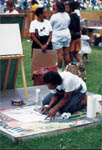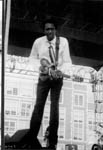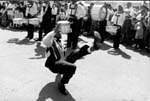By Reynauld Harris
“It rained and rained and rained.” This was the first Denver Black Arts Festival as described by Perry Ayers , its co-founder and leader. From these humble beginnings to the huge success it is today was an arduous, often disheartening, yet always inspiring journey. , its co-founder and leader. From these humble beginnings to the huge success it is today was an arduous, often disheartening, yet always inspiring journey.
On this Monday morning, as I prepared to meet Ayers at a local Five Points eatery, the weather was sunny and bright. “Welcome to Blackberries.” I heard it before I saw who said it. Once my eyes adjusted, I discerned it was the brother behind the counter who’d issued the habitual greeting. I thanked him, continued into the clean, classy café and settled into a thick red easy chair before a huge picture window to await my interviewee.
Only a few minutes had passed when a tall, slim, dark-skinned gentleman entered, crossed directly to my table and introduced himself as Perry Ayers. His smile was bright and sincere. Sitting opposite me, he removed a brightly colored skullcap to reveal a bald pate. As he was quite casual in manner and dress, it was not long before my initial nervousness, customary when meeting someone for the first time, dissipated.
Ayers was born in Burk Burnett, Texas, “on the Red River,” to a family of artists. Early occupations included working as a radio broadcaster, hosting a gospel music show, holding a “regular” 9 to 5 gig he never identified, and dancing with Cleo Parker Robinson. “But I don’t want to tell you how far back that was,” he said. Then, sometime in 1986, he, his brother Oye Oginga, and a small contingent of artists and art lovers, sensing a void within the community, created the Denver Black Arts Festival. This year, 2006, will commemorate its 20th anniversary.
Ayers recalled the first festival in August of ’87, when it rained for two days straight, resulting in an abbreviated half-day affair. The following year, in an attempt to avoid Denver’s monsoon season, they moved the festival to July. That and changing its venue from a small lot in Five Points to a spacious City Park locale contributed to its success, as 2,500 art lovers participated. The third year attracted 10 to15,000 and the festival was off and running. In 1990, the attendance reached 60,000 and finally leveled off in ’91 to 100,000 souls.
Commenting on the obstacles encountered during the festival’s long history, Ayers said financing was an issue, especially at the beginning. Were they operating on a shoestring? “More like shoes without strings,” said Ayers. In those days it was about being adaptable, he stressed, doing whatever was required, such as building stages and backdrops by hand.
His voice sobered in tone when he spoke of the shooting that occurred at the ’95 festival when a young man was wounded. Ayers felt that the incident was exaggerated by the local press. Deacons, ministers, and other community leaders came to the festival’s support, Ayers emphasized. “They were there. They decided this was not going to die. What could have been a real setback instead became a rallying point.”
He spoke warmly of 1993 when, during the middle of the festival, “a nice, warm rain began to fall.” Then something magical happened. As the organizers were debating whether to suspend proceedings, they noticed that the crowd hadn’t moved. “We said to ourselves, ‘These people are not leaving.’” So the band played on. At that moment a bond formed between the festival and the community that lasts to this day. “I am so big on giving accolades to the community for its support over the years,” said Ayers, “It is a credit to those who stuck with it.”

Then there was the 10th anniversary celebration in 1997, when expenditures far exceeded revenue. So scrapped were they for funds that sitting out a year was seriously considered. But to do so, the committee concluded, would be interpreted as a sign of weakness. So they regrouped, cutting back on staff and expenses, channeling all resources into the event itself.
They devised creative money saving measures such as moving the festival to East High School (where it stayed for several years), reducing its size (fewer stages, less vendor space), and generally downscaling. “You have to adjust according to income, and that dictates how you present the event,” said Ayers. Those adjustments, coupled with a surge of support from the arts and cultural community, saw them through that rocky period.
Ayers became animated talking about the impact he felt art in general had on the African American community. “It’s a recording of history —a documentation of us as a people. It reflects images of who we are, represents where we’ve been and dictates our future. It opens doors for opportunity and instills a tremendous sense of pride and well being. It makes people feel good about themselves,” he said.
“African American art is the most dominant art form in America. In slavery, you took what you had and made it into something special, whether food, hair, clothes, or language. We (Blacks) create the trend, and the dominant culture takes it, refines it, and sells it back to us!”
Discussing this year’s festival, his eyes brightened. The upcoming festival will be expanded to five days, as it is every five years, and will run from July 12 to July 16. Also, it will be moved from Sonny Larson Park back to City Park, featuring several events in other venues, such as downtown Denver and the Museum of Nature and Science.
Ayers then elaborated on the meaning of this year’s slogan, “A Score for Change.” “Score” refers to the 20 years the festival has lived, and “Change” to the changes (venue, program, emphasis, and ideas) that this year’s festival embodies. The concept of change, in fact, was a motif to which he returned several times. He envisions the festival as a work of art itself and as an organic entity, forever evolving, never redundant, and literally born again year after year. He never wants to see the festival become predictable --lose its freshness, its vibrancy, its sense of mystery, surprise, and unpredictability.
And, just as Black History Month has become a yearlong celebration, he sees the festival, ideally, as having an impact far beyond the few days it occurs. In addition to coming and having a good time, he urges participants to take something back with them—a new attitude, inspiration, appreciation or work of art—to enrich their lives and that of their children.
Ayers readily admits he is seeking to pass the torch and step down as the e xecutive d irector. But he is adamant that whoever becomes keeper of the flame must not compromise the authenticity of the festival as an embodiment of the unique African American artistic spirit. “People love it for what it is,” he stressed. “If it ain’t broke, don’t fix it. I would be disappointed, for example, to go to the Cherry Blossom Festival and see bagpipes.” His was an impassioned plea against diversifying in order to make money.
As we wrapped up, Ayers made two final pleas: one to the community and the other to the corporate sector. To the community, he said, “Seek out opportunities to make the festival successful. Be giving, supportive. Don’t be negative, apathetic or take things for granted. Don’t be afraid to get involved. Volunteer time, buy a vendor space, spread the word and give a contribution. Take ownership.  Success depends on positive, not negative input. It’s all about energy. We can’t do it without you.” To the corporate sector, he said, “Give us the financial support to make the festival successful. Give back to the African American community for using your products and services. Dig deeper. Find a way. Please, please.” Success depends on positive, not negative input. It’s all about energy. We can’t do it without you.” To the corporate sector, he said, “Give us the financial support to make the festival successful. Give back to the African American community for using your products and services. Dig deeper. Find a way. Please, please.”
The interview wrapped up, and as my eyes readjusted to the sunshine, I felt a sense of satisfaction and anticipation, looking forward to July and a great Black Arts Festival.
Also Read:
Denver Black Arts Festival
Returns To City Park West To Celebrate 20th
Anniversary Moyo Ogundipe |
